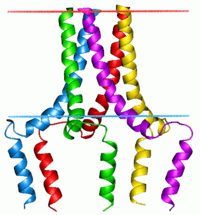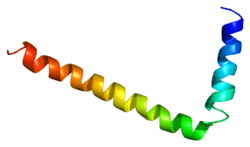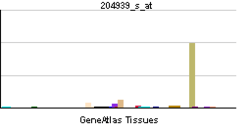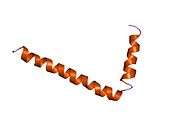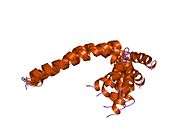Phospholamban
|
Phospholamban pentamer | |||||||||
| Identifiers | |||||||||
|---|---|---|---|---|---|---|---|---|---|
| Symbol | Phospholamban | ||||||||
| Pfam | PF04272 | ||||||||
| InterPro | IPR005984 | ||||||||
| SCOP | 1fjk | ||||||||
| SUPERFAMILY | 1fjk | ||||||||
| TCDB | 1.A.50 | ||||||||
| OPM superfamily | 70 | ||||||||
| OPM protein | 1zll | ||||||||
| |||||||||
| View/Edit Human | View/Edit Mouse |
Phospholamban, also known as PLN or PLB, is a protein that in humans is encoded by the PLN gene.[3] Phospholamban is a 52-amino acid integral membrane protein that regulates the Ca2+ pump in cardiac muscle cells.[4]
Function
This protein is found as a pentamer and is a major substrate for the cAMP-dependent protein kinase (PKA) in cardiac muscle. The protein is an inhibitor of cardiac muscle sarcoplasmic reticulum Ca++-ATPase (SERCA2)[5] in the unphosphorylated state, but inhibition is relieved upon phosphorylation of the protein. The relief of inhibition on Ca++-ATPase leads to faster Ca++ uptake into the sarcoplasmic reticulum, thereby contributing to the lusitropic response elicited in heart by beta-agonists. The protein is a key regulator of cardiac diastolic function . Mutations in this gene are a cause of inherited human dilated cardiomyopathy with refractory congestive heart failure.[6]
When phospholamban is phosphorylated by PKA its ability to inhibit the sarcoplasmic reticulum calcium pump (SERCA) is lost.[7] Thus, activators of PKA, such as the beta-adrenergic agonist epinephrine (released by sympathetic stimulation), may enhance the rate of cardiac myocyte relaxation. In addition, since SERCA is more active, the next action potential will cause an increased release of calcium, resulting in increased contraction (positive inotropic effect). When phospholamban is not phosphorylated, such as when PKA is inactive, it can interact with and inhibit SERCA. The overall effect of phospholamban is to decrease contractility and the rate of muscle relaxation , thereby decreasing stroke volume and heart rate, respectively.[8]
Clinical significance
Gene knockout of phospholamban results in animals with hyperdynamic hearts, with little apparent negative consequence.[9]
Mutations in this gene are a cause of inherited human dilated cardiomyopathy with refractory congestive heart failure .[10]
Discovery
Phospholamban was discovered by Arnold Martin Katz and coworkers in 1974.[11]
Interactions
PLN has been shown to interact with SLN[12][13] and ATP2A1.[13][14][15]
References
- ↑ "Human PubMed Reference:".
- ↑ "Mouse PubMed Reference:".
- ↑ Fujii J, Zarain-Herzberg A, Willard HF, Tada M, MacLennan DH (June 1991). "Structure of the rabbit phospholamban gene, cloning of the human cDNA, and assignment of the gene to human chromosome 6". J. Biol. Chem. 266 (18): 11669–75. PMID 1828805.
- ↑ Rodriguez P, Kranias EG (December 2005). "Phospholamban: a key determinant of cardiac function and dysfunction". Arch Mal Coeur Vaiss. 98 (12): 1239–43. PMID 16435604.
- ↑ https://www.ebi.ac.uk/interpro/potm/2004_3/Page2.htm
- ↑ "Entrez Gene: PLN phospholamban".
- ↑ Medical Physiology. Philadelphia: Saunders. 2004. ISBN 0-8089-2333-1.
- ↑ Brittsan AG, Kranias EG (December 2000). "Phospholamban and cardiac contractile function". J. Mol. Cell. Cardiol. 32 (12): 2131–9. doi:10.1006/jmcc.2000.1270. PMID 11112989.
- ↑ Luo W, Grupp IL, Harrer J, Ponniah S, Grupp G, Duffy JJ, Doetschman T, Kranias EG (September 1994). "Targeted ablation of the phospholamban gene is associated with markedly enhanced myocardial contractility and loss of beta-agonist stimulation". Circ. Res. 75 (3): 401–9. doi:10.1161/01.res.75.3.401. PMID 8062415.
- ↑ Schmitt JP, Kamisago M, Asahi M, Li GH, Ahmad F, Mende U, Kranias EG, MacLennan DH, Seidman JG, Seidman CE (February 2003). "Dilated cardiomyopathy and heart failure caused by a mutation in phospholamban". Science. 299 (5611): 1410–3. doi:10.1126/science.1081578. PMID 12610310.
- ↑ Tada M, Kirchberger MA, Repke DI, Katz AM (October 1974). "The stimulation of calcium transport in cardiac sarcoplasmic reticulum by adenosine 3':5'-monophosphate-dependent protein kinase". J Biol Chem. 249 (19): 6174–80. PMID 4371608.
- ↑ Asahi, Michio; Sugita Yuji; Kurzydlowski Kazimierz; De Leon Stella; Tada Michihiko; Toyoshima Chikashi; MacLennan David H (Apr 2003). "Sarcolipin regulates sarco(endo)plasmic reticulum Ca2+-ATPase (SERCA) by binding to transmembrane helices alone or in association with phospholamban". Proc. Natl. Acad. Sci. U.S.A. United States. 100 (9): 5040–5. doi:10.1073/pnas.0330962100. ISSN 0027-8424. PMC 154294
 . PMID 12692302.
. PMID 12692302. - 1 2 Asahi, Michio; Kurzydlowski Kazimierz; Tada Michihiko; MacLennan David H (Jul 2002). "Sarcolipin inhibits polymerization of phospholamban to induce superinhibition of sarco(endo)plasmic reticulum Ca2+-ATPases (SERCAs)". J. Biol. Chem. United States. 277 (30): 26725–8. doi:10.1074/jbc.C200269200. ISSN 0021-9258. PMID 12032137.
- ↑ Asahi, M; Kimura Y; Kurzydlowski K; Tada M; MacLennan D H (Nov 1999). "Transmembrane helix M6 in sarco(endo)plasmic reticulum Ca(2+)-ATPase forms a functional interaction site with phospholamban. Evidence for physical interactions at other sites". J. Biol. Chem. UNITED STATES. 274 (46): 32855–62. doi:10.1074/jbc.274.46.32855. ISSN 0021-9258. PMID 10551848.
- ↑ Asahi, M; Green N M; Kurzydlowski K; Tada M; MacLennan D H (Aug 2001). "Phospholamban domain IB forms an interaction site with the loop between transmembrane helices M6 and M7 of sarco(endo)plasmic reticulum Ca2+ ATPases". Proc. Natl. Acad. Sci. U.S.A. United States. 98 (18): 10061–6. doi:10.1073/pnas.181348298. ISSN 0027-8424. PMC 56915
 . PMID 11526231.
. PMID 11526231.
This article incorporates text from the United States National Library of Medicine, which is in the public domain.
